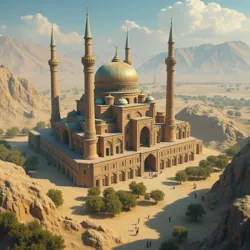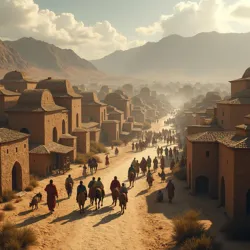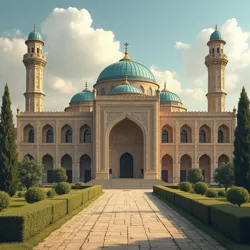Ferghana Khanate

Depicts the Ferghana Khanate, a significant polity in Central Asia known for its strategic location and rich cultural heritage.
فیرغانه خانلیغی
uzb
Ferghana Khanate
Asia
Central Asia
Kokand (historical), Ferghana (modern)
Khanate
Sunni Islam
14th Century
فیرغانه خانلیغی
uzb
Ferghana Khanate
Map depicting the approximate extent of the Ferghana Khanate and its surrounding regions.
Asia
Central Asia
File:Flag of Jade Lands.svg|20px|border Jade Lands, File:Flag of Samarkand Sultanate.svg|20px|border Samarkand Sultanate
Kokand (historical), Ferghana (modern)
Khanate
Sunni Islam
Ferghanese Turkic, Persian (administrative)
Age of Contending States - Modern Era
14th Century
Ongoing
The Ferghana Khanate (费尔干纳汗国, Fèi'ěrgān Nà Hànguó; Ferghanese Turkic: فیرغانه خانلیغی, Ferğane Xanlığı) is a significant polity located to the west of the Jade Lands, nestled in the fertile Ferghana Valley region. Known for its rich agricultural lands, strategic location along ancient trade routes, and a vibrant cultural heritage, the Khanate has played a pivotal role in the history of Central Asia and in the complex interactions between the Islamic polities and the states of the Jade Lands. The Ferghana Khanate is bordered by the Samarkand Sultanate to the west and various nomadic groups to the north and south, maintaining a critical position in the geopolitical landscape of the region. Its people, predominantly Ferghanese Turks, adhere to Sunni Islam and speak a Turkic language closely related to other Central Asian Turkic dialects, with Persian serving as a prominent language of administration and high culture.
History
Origins and Establishment
 Depicts the historical origins of the Khanate, tracing back to the fragmentation of empires and its establishment in the Ferghana Valley by the 14th century.
Depicts the historical origins of the Khanate, tracing back to the fragmentation of empires and its establishment in the Ferghana Valley by the 14th century.The Ferghana Khanate traces its origins back to the fragmentation of larger empires that once dominated Central Asia. Following the period of Mongol rule, which had a profound impact on the region in the 13th century, various successor states and khanates emerged. In the Ferghana Valley, local Turkic and Persian elites, leveraging the agricultural wealth and strategic importance of the region, gradually consolidated their power. By the 14th century, amidst the broader political flux of the Age of Contending States in the Jade Lands and concurrent shifts in Central Asia, a distinct Khanate began to solidify its form in Ferghana.
Unlike the states of the Jade Lands, which emerged from the splintering of the Tang Dynasty and developed along lines influenced by the Concordian Way, the Ferghana Khanate’s formative influences were rooted in Islamic traditions and Central Asian Turkic culture. The Timurid Empire, which rose to prominence in the 14th and 15th centuries, exerted considerable influence over Ferghana and the surrounding areas. Although not directly incorporated as a province, Ferghana benefited from the relative stability and flourishing trade that Timurid rule often brought. Following the decline of the Timurids, local dynasties vied for control, eventually leading to the establishment of a more consistently independent Khanate.
The early rulers of the Ferghana Khanate were instrumental in laying the foundations of the polity. They focused on consolidating control over the Ferghana Valley, establishing administrative structures, and promoting agriculture and trade. The city of Kokand rose in prominence during this period, eventually becoming the capital of the Khanate. These early Khans often had to balance their ambitions against powerful neighbors, including various Uzbek and Kyrgyz groups, as well as the nascent Samarkand Sultanate.
Expansion and Consolidation
Over the 15th and 16th centuries, the Ferghana Khanate experienced periods of expansion and consolidation, punctuated by internal strife and external pressures. The Khanate's prosperity was largely based on its fertile agricultural lands, which produced abundant grains, fruits, and cotton. Furthermore, Ferghana's location along the Silk Roads continued to be of immense importance, allowing the Khanate to profit from overland trade between the Jade Lands, Persia, and the West. Khanate Caravanserais, strategically located throughout the region, facilitated this commerce and provided vital infrastructure for merchants and travelers.
The Khans of Ferghana often engaged in complex diplomatic and military maneuvering to secure their position. They formed alliances and waged wars against neighboring polities, including the Samarkand Sultanate and various nomadic confederations. Control over key trade routes and oasis cities was a constant source of contention. At times, the Ferghana Khanate was able to exert influence over surrounding territories, extending its reach into parts of modern-day Tajikistan and Kyrgyzstan.
During this period, the Khanate also developed a distinct cultural identity, characterized by a blend of Turkic and Persian traditions, all within an Islamic framework. Persian remained the language of court and administration, while Ferghanese Turkic was the vernacular of the majority of the population. Islamic scholarship and Sufi orders flourished, contributing to the intellectual and spiritual life of the Khanate. Madrasas (religious schools) were established in Kokand and other cities, attracting scholars and students from across Central Asia.
Relations with the Jade Lands
The Ferghana Khanate's relationship with the Jade Lands has been a long and multifaceted one, marked by periods of both trade and conflict. As the Jade Lands fractured into independent states during the Ten Kingdoms Era and subsequently the Age of Contending States, the Ferghana Khanate emerged as a significant western neighbor, interacting with various Jade Lands polities in diverse ways.
Trade was a central aspect of this relationship. The Silk Roads passed through both the Ferghana Khanate and the Jade Lands, facilitating the exchange of goods. Jade, silk, porcelain, and other valuable commodities from the Jade Lands flowed westward through Ferghana, while textiles, horses, and various Central Asian goods were traded eastward. Liangning City, a major trading hub in the Jade Lands, was connected to Ferghana through established caravan routes. Merchants from Jing-Hua and other coastal states also engaged in trade with Ferghana, accessing overland routes to the west.
However, relations were not always peaceful. Border disputes and competition for control over trade routes sometimes led to military clashes. During periods of expansion by either the Ferghana Khanate or Jade Lands states like Liang-Ning, conflicts could arise, particularly in the regions bordering the Tian Shan mountains. Religious differences also played a role, although trade and pragmatic political considerations often outweighed purely religious tensions.
The Mount Hua Holy See, the center of the Concordian Way in the Jade Lands, occasionally played a mediating role in disputes between Jade Lands states and the Ferghana Khanate. While the Khanate was an Islamic polity, the Holy See's influence as a neutral and respected religious authority within the Jade Lands could be leveraged to facilitate dialogue and peaceful resolution of conflicts. Emissaries from the Harmonious Pontiff sometimes traveled to Kokand to engage in diplomatic discussions with the Khan.
In the 19th century, as Western powers began to exert influence across Asia, both the Jade Lands and the Ferghana Khanate faced new challenges. The period of Western Intrusion into the Jade Lands had indirect but significant effects on the Ferghana Khanate. The disruption of traditional trade routes and the growing power of Western-backed states in the east altered the geopolitical landscape.
Decline and Modern Era
The 19th century marked a period of increasing pressure and eventual decline for the Ferghana Khanate. While the Khanate had managed to maintain its independence for centuries, internal divisions, external threats, and the changing global balance of power gradually eroded its strength.
Internal strife, including dynastic struggles and regional rebellions, weakened the Khanate from within. Competing factions within the ruling elite vied for power, leading to instability and hindering effective governance. Economic challenges, partly due to shifts in global trade patterns and competition from industrialized economies, also contributed to the Khanate's difficulties.
Externally, the Samarkand Sultanate, to the west, posed a persistent threat, with ongoing border disputes and military conflicts. Furthermore, the expansion of other powers in Central Asia, mirroring the Western Intrusion in the Jade Lands, put increasing pressure on the Ferghana Khanate. By the late 19th century, the Khanate found itself increasingly vulnerable.
Despite these challenges, the Ferghana Khanate maintained a degree of cultural and economic vitality into the modern era. Kokand and Ferghana remained important centers of trade and Islamic learning. However, the Khanate's political independence was increasingly precarious. In the 20th century, the region underwent further transformations as new political entities emerged in Central Asia.
Today, the legacy of the Ferghana Khanate is evident in the cultural landscape of the Ferghana Valley and in the historical consciousness of its people. The Khanate's history of trade, cultural exchange, and interactions with the Jade Lands continues to shape the region's identity and its place in the broader Asian context.
Politics and Governance
The Ferghana Khanate was traditionally governed as a Khanate, a form of monarchy common among Turkic and Mongol peoples of Central Asia. The Khan, the supreme ruler, held ultimate political, military, and judicial authority, although in practice, his power was often influenced by powerful tribal leaders, religious figures, and administrative elites.
Structure of Government
The Khanate's government was structured around a hierarchical system, with the Khan at the apex. Beneath the Khan were various officials and administrators who managed different aspects of governance. These included viziers (chief ministers), military commanders, tax collectors, and judges. Appointments to these positions were often based on a combination of merit, lineage, and personal connections to the Khan.
Tribal structures played a significant role in the Khanate's political system. Powerful tribal confederations, such as the Uzbeks and Kyrgyz, often exerted considerable influence on the Khan and the affairs of state. Khans had to maintain alliances and manage relations with these tribal groups, sometimes through negotiation, sometimes through military force. Regional governors, often drawn from these tribal elites, administered different provinces of the Khanate, enjoying a degree of autonomy while remaining ultimately accountable to the Khan.
Islamic law, or Sharia, formed the basis of the Khanate's legal system. Qadis (judges) interpreted and applied Islamic law in courts, handling civil and criminal cases. Religious scholars, or Ulama, played an important role in advising the Khan on matters of law and religion, and in maintaining the legitimacy of the Khanate as an Islamic polity. However, customary law and local traditions also influenced legal practices, particularly in rural areas.
Military
The military strength of the Ferghana Khanate was crucial for its survival and its interactions with neighboring polities. The Khanate relied on a combination of cavalry forces, reflecting its Central Asian Turkic heritage, and infantry, particularly for siege warfare and defense of fortified cities.
Cavalry formed the core of the Khanate's army. Ferghana was known for its horses, and Ferghanese cavalry were renowned for their horsemanship and mobility. These forces were typically composed of lightly armored horsemen armed with bows, swords, and spears, well-suited for raiding and open-field battles. Elite units, often drawn from the Khan's personal guard and tribal contingents, were better equipped and trained.
Infantry played a supporting role, but their importance grew over time, especially with the introduction of firearms. The Khanate gradually adopted gunpowder weapons, including cannons and muskets, often acquiring them through trade with the Jade Lands and other regions. Fortified cities and towns relied on infantry garrisons for defense, and infantry units were deployed in sieges and pitched battles alongside cavalry.
The Khanate's military organization was often decentralized, with tribal levies forming a significant portion of the armed forces. In times of war, the Khan would mobilize these tribal contingents, along with his standing army and professional soldiers. Military campaigns were often seasonal, dictated by agricultural cycles and the availability of resources.
Economy and Society
The Ferghana Khanate's economy was based on a combination of agriculture, trade, and crafts. Its society was diverse, reflecting the region's history as a crossroads of cultures and migrations.
 Shows the Ferghana Khanate's economic activity centered around Silk Road trade, highlighting caravanserais and the exchange of goods between East and West.
Shows the Ferghana Khanate's economic activity centered around Silk Road trade, highlighting caravanserais and the exchange of goods between East and West.Economy
Agriculture was the backbone of the Ferghana Khanate's economy. The Ferghana Valley, with its fertile soil and abundant water resources from rivers and irrigation systems, was highly productive. Key crops included wheat, barley, rice, cotton, fruits (such as melons and grapes), and vegetables. Irrigation systems, often dating back to ancient times, were essential for maximizing agricultural output. Land ownership varied, ranging from state-owned lands to private holdings and religious endowments.
Trade played a vital role in the Khanate's prosperity. Located along the Silk Roads, Ferghana benefited from overland trade between East and West. Jing River and Liang River trade routes, though distant, indirectly connected to Ferghana through transcontinental networks. Merchants from the Jade Lands, Persia, India, and other regions frequented Ferghana's cities, exchanging goods. Major trading centers included Kokand, Ferghana, and Andijan. Goods traded included silk, textiles, cotton, horses, livestock, dried fruits, nuts, ceramics, and metalwork. Taxes on trade and tariffs on goods passing through the Khanate were significant sources of revenue.
Craft production was also important, particularly in urban centers. Artisans in Ferghana produced a variety of goods, including textiles (silk and cotton fabrics), ceramics, metalwork (weapons, tools, household items), leather goods, and carpets. Guilds and workshops organized craft production, often catering to both local and export markets.
Society
Ferghana Khanate's society was characterized by a hierarchical structure, with the ruling elite at the top, followed by religious scholars, merchants, landowners, artisans, and peasants. Social mobility existed, but was often limited by birth and social status.
Ethnic diversity was a notable feature of Ferghana society. While Ferghanese Turks formed the majority, significant Persian-speaking populations, as well as Uzbeks, Kyrgyz, and other groups, resided within the Khanate. These ethnic groups often maintained distinct cultural identities and languages, while also interacting and intermingling.
Family and kinship ties were central to social organization. Tribal affiliations remained important, particularly in rural areas and among nomadic groups. Patrilineal descent and extended family structures were common. Marriage was a key social institution, often arranged and serving to solidify social and economic alliances.
Religious life was deeply intertwined with society. Sunni Islam was the dominant religion, and Islamic institutions, such as mosques, madrasas, and Sufi lodges, played central roles in community life, education, and social welfare. Religious festivals and ceremonies marked the annual cycle. Sufi orders, with their emphasis on mysticism and spiritual guidance, had a significant following and often exerted social and political influence.
Culture and Religion
The culture of the Ferghana Khanate was a rich tapestry woven from Turkic, Persian, and Islamic threads. Religion, particularly Sunni Islam, permeated many aspects of life, influencing law, education, art, and social customs.
 Illustrates the Islamic culture within the Khanate, showcasing mosques, madrasas, and the influence of Sunni Islam on society and art.
Illustrates the Islamic culture within the Khanate, showcasing mosques, madrasas, and the influence of Sunni Islam on society and art.Islamic Practices
Sunni Islam, of the Hanafi school of jurisprudence, was the state religion of the Ferghana Khanate. The Khan himself was expected to be a devout Muslim and to uphold Islamic law. Religious institutions were supported by the state and by private endowments (Waqf).
Mosques were the centers of religious life in every town and village, serving as places of worship, community gathering, and education. Friday prayers and sermons were important social and religious events. Madrasas, religious colleges, provided advanced education in Islamic theology, law, jurisprudence, and related subjects. These institutions played a crucial role in training religious scholars and administrators.
Sufism, Islamic mysticism, was widely practiced in the Ferghana Khanate. Various Sufi orders, such as the Naqshbandiyya and Yasaviyya, had a large following and established lodges (Khanqah) throughout the region. Sufi Sheikhs (spiritual leaders) were revered for their piety and wisdom, and often played a role in social and political life. Pilgrimages to Sufi shrines and the observance of Sufi rituals were common practices.
Art and Architecture
Art and architecture in the Ferghana Khanate reflected a blend of Central Asian Turkic and Persian Islamic styles. Architectural traditions were influenced by Timurid and earlier Islamic styles, adapted to local materials and tastes.
Mosques, madrasas, mausoleums, and Khan's palaces were prominent architectural forms. Brick and tilework were commonly used, often featuring intricate geometric patterns, floral motifs, and Arabic calligraphy. Dome structures, arches, and courtyards were characteristic elements of Ferghanese architecture. Examples of notable architecture can be found in Kokand, the historical capital, and other cities of the Khanate.
Visual arts included calligraphy, manuscript illumination, miniature painting, and ceramics. Calligraphy, as an art form associated with the Quran, was highly esteemed. Manuscripts of the Quran and other religious texts were often richly decorated with illumination and calligraphy. Miniature painting, influenced by Persian traditions, depicted scenes from literature, history, and court life. Ceramics produced in Ferghana were known for their distinctive styles and patterns.
Literature and Scholarship
Literature and scholarship flourished in the Ferghana Khanate, with both Persian and Turkic languages used for literary expression. Persian remained the language of high culture, poetry, and scholarly works, while Turkic languages, including Ferghanese Turkic, were used for oral literature, folk tales, and increasingly for written works as well.
Poetry was a highly valued art form, with both classical Persian forms and Turkic poetic traditions practiced. Epic poems, lyrical verses, and Sufi poetry were popular genres. Famous poets and writers emerged from Ferghana, contributing to the rich literary heritage of Central Asia.
Scholarly activity was centered in madrasas and libraries. Religious scholars produced works on Islamic law, theology, jurisprudence, and Quranic commentary. Historical chronicles, biographical dictionaries, and geographical treatises were also compiled. Scientific learning, including mathematics, astronomy, and medicine, was pursued, often building upon earlier Islamic scholarship. The intellectual traditions of the Ferghana Khanate contributed to the broader Islamic intellectual world and to the cultural exchange between Central Asia and the Jade Lands.
Relations with the Jade Lands (Detailed)
The interactions between the Ferghana Khanate and the Jade Lands were characterized by a complex interplay of trade, diplomacy, and occasional conflict. These relations were shaped by geographical proximity, shared trade routes, and differing cultural and religious identities.
Trade Networks
Trade formed the most consistent and mutually beneficial aspect of the relationship between the Ferghana Khanate and the Jade Lands states. The Silk Roads, traversing both regions, served as vital arteries for commerce. Ferghana acted as a crucial entrepôt for goods flowing between the Jade Lands and the West.
Caravanserais in Ferghana, such as those in Kokand and Andijan, served as major hubs for merchants from the Jade Lands. Khanate Caravanserais provided secure lodging, warehousing, and trading facilities. Merchants from Liang-Ning, Jing-Hua, and other Jade Lands states traveled to Ferghana, exchanging goods and establishing commercial networks. Jade, a highly prized commodity in the Jade Lands, was traded westward, while silk, porcelain, tea, and other Jade Lands products were sought after in Ferghana and beyond. Horses, livestock, textiles, and various Central Asian goods were traded eastward into the Jade Lands.
The Treaty of Heavenly Mountains, while primarily defining borders, also indirectly facilitated trade by establishing a framework for managing cross-border interactions. While not directly between the Ferghana Khanate and Jade Lands states, it regulated the broader regional environment, impacting trade flows.
Diplomatic Exchanges
Diplomatic relations between the Ferghana Khanate and Jade Lands states were often pragmatic and focused on managing trade, border issues, and regional stability. Embassies were exchanged, particularly with Liang-Ning and Jing-Hua, the Jade Lands states most directly involved in overland trade with the west.
The Mount Hua Holy See occasionally served as a channel for diplomatic communication and mediation. The Harmonious Pontiff's envoys, respected across the Jade Lands and even beyond, could facilitate dialogue between the Ferghana Khanate and Jade Lands polities, helping to resolve disputes and promote peaceful relations.
Alliances were sometimes formed for strategic purposes, although these were often fluid and short-lived, dictated by immediate political needs. Jade Lands states and the Ferghana Khanate occasionally cooperated against common threats, such as nomadic incursions or banditry along trade routes.
Cultural Exchange
Cultural exchange, though less formally structured than trade or diplomacy, also occurred between the Ferghana Khanate and the Jade Lands. Merchants, travelers, and scholars facilitated the flow of ideas and cultural influences.
Islamic scholarship and Sufi traditions from Ferghana and other Central Asian centers had some influence in the western regions of the Jade Lands, particularly in areas bordering Islamic polities. Conversely, elements of Jade Lands culture, including artistic styles and philosophical concepts, may have found their way westward through trade and cultural diffusion. The Zhongyuan language family and the Turkic languages of Central Asia, while distinct, represent broader linguistic connections across the continent, reflecting historical migrations and interactions.
Points of Conflict
Despite the generally beneficial aspects of trade and diplomacy, points of conflict also arose between the Ferghana Khanate and Jade Lands states. Border disputes, particularly in the mountainous regions along the Tian Shan range, were a recurring source of tension. Competition for control over trade routes and oasis cities could also lead to military clashes.
Religious differences, while not always the primary cause of conflict, could exacerbate tensions. While pragmatic cooperation often prevailed, religious identities played a role in shaping perceptions and interactions. Jade Lands states, adhering to the Concordian Way, and the Ferghana Khanate, an Islamic polity, represented distinct religious and cultural spheres.
Military campaigns by expanding Jade Lands states, such as Liang-Ning, or by the Ferghana Khanate itself, could lead to incursions into border regions and conflicts over territory and influence. However, large-scale, protracted wars between the Ferghana Khanate and Jade Lands states were less common than localized border skirmishes and trade disputes.
Legacy and Significance
The Ferghana Khanate holds a significant place in the history of Central Asia and in the broader context of interactions between the Islamic world and East Asia. Its legacy encompasses economic, cultural, and political dimensions.
Economically, the Khanate's role as a key link in the Silk Roads trade network was of immense importance. It facilitated the exchange of goods and ideas between the Jade Lands, Persia, and the West for centuries, contributing to regional and global commerce. The agricultural wealth of the Ferghana Valley and the craftsmanship of its artisans further contributed to its economic significance.
Culturally, the Ferghana Khanate was a vibrant center of Islamic learning, literature, and art. It fostered a synthesis of Turkic and Persian traditions within an Islamic framework, producing a distinctive cultural heritage. Its madrasas, mosques, and literary works contributed to the broader Islamic intellectual world. The Khanate's cultural interactions with the Jade Lands, though less prominent than trade relations, also played a role in the cross-cultural exchange across Asia.
Politically, the Ferghana Khanate represents a long-lasting independent polity in Central Asia, navigating complex geopolitical landscapes for centuries. It maintained its autonomy amidst powerful neighbors and internal challenges, demonstrating resilience and adaptability. Its interactions with the Jade Lands states, characterized by a mix of cooperation and competition, shaped regional dynamics and contributed to the broader history of inter-state relations in Asia. The Khanate's history provides valuable insights into the political, economic, and cultural dynamics of Central Asia and its interactions with the Jade Lands region.